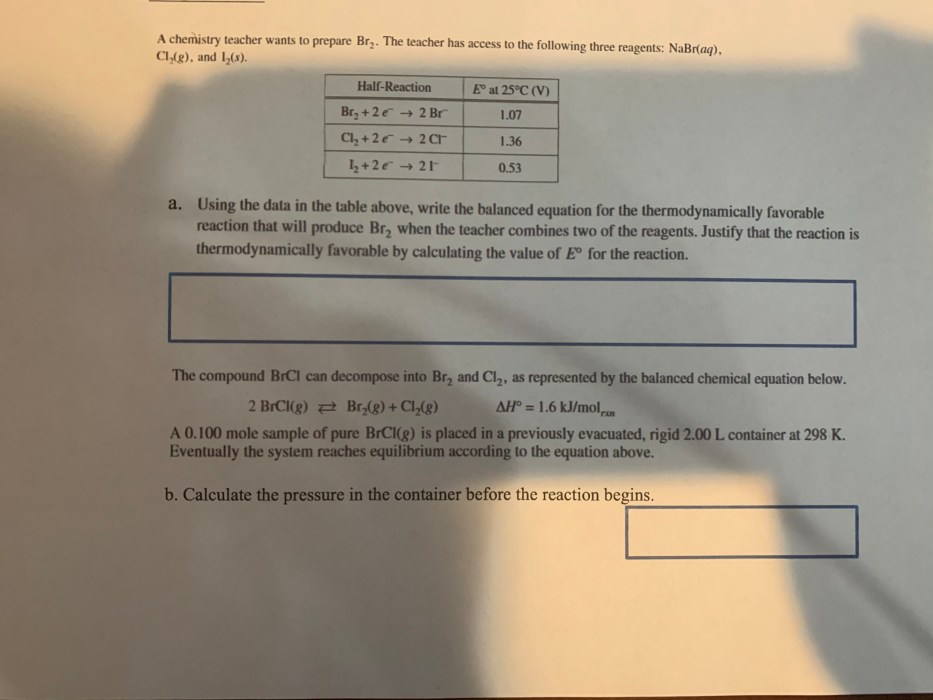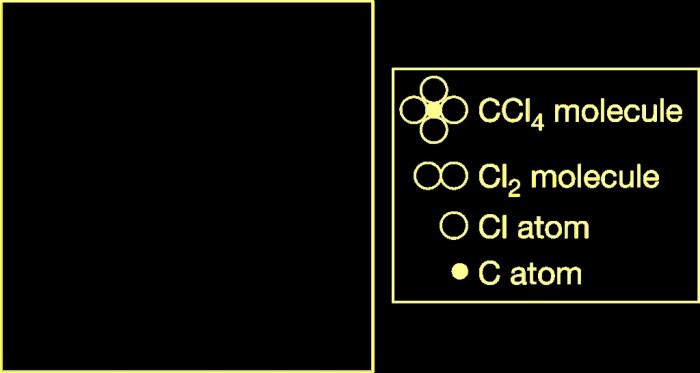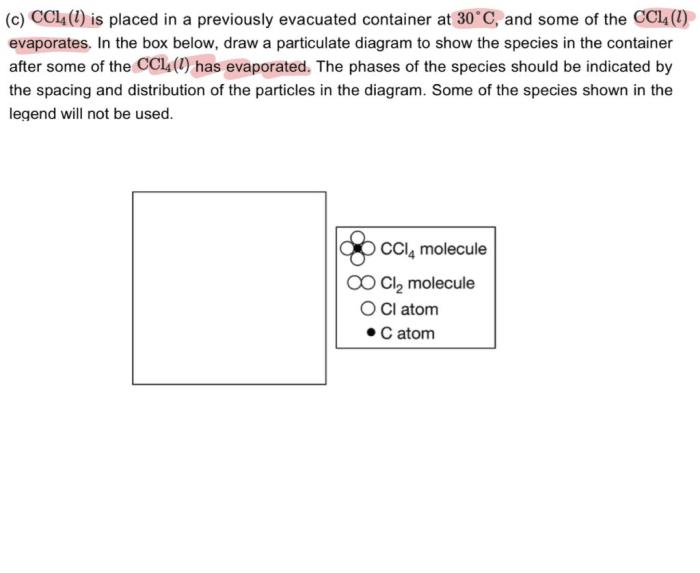When CCl4 is placed in a previously evacuated container, it undergoes fascinating physical transformations, offering insights into its properties and potential applications. This article delves into the behavior of CCl4 in evacuated containers, exploring its molecular structure, vapor pressure, and practical uses.
As CCl4 enters the evacuated space, its molecules gain increased freedom, leading to changes in its physical state and properties. The absence of external pressure allows CCl4 to vaporize more readily, creating a dynamic equilibrium between liquid and gas phases.
Physical Properties of CCl4

Carbon tetrachloride (CCl4) is a colorless, non-flammable liquid with a characteristic pungent odor. It is a member of the halogenated hydrocarbon family and has the chemical formula CCl4. CCl4 is a dense liquid with a specific gravity of 1.595 at 20 °C.
It has a boiling point of 76.7 °C and a melting point of -23 °C. CCl4 is insoluble in water and soluble in organic solvents such as benzene, chloroform, and ether.
Molecular Structure and Bonding Characteristics, Ccl4 is placed in a previously evacuated container
The molecular structure of CCl4 is tetrahedral, with the carbon atom at the center and the four chlorine atoms at the corners. The carbon-chlorine bond length is 1.77 Å. The CCl4 molecule is nonpolar and has a dipole moment of zero.
Behavior of CCl4 in an Evacuated Container
When CCl4 is placed in a previously evacuated container, it will vaporize and fill the container. The vapor pressure of CCl4 is high, so it will evaporate quickly at room temperature. The vapor pressure of CCl4 increases with temperature. At 20 °C, the vapor pressure of CCl4 is 11.9 kPa.
At 50 °C, the vapor pressure of CCl4 is 36.8 kPa.
Changes in Physical State and Properties
As CCl4 vaporizes, it will condense on the walls of the container. The condensed CCl4 will form a liquid layer on the walls of the container. The liquid layer will increase in thickness as more CCl4 vaporizes. The vapor pressure of CCl4 will decrease as the liquid layer increases in thickness.
Vapor Pressure and Evaporation
The vapor pressure of a liquid is the pressure exerted by the vapor of the liquid when it is in equilibrium with the liquid. The vapor pressure of a liquid increases with temperature. The rate of evaporation of a liquid is proportional to the vapor pressure of the liquid.
Process of Evaporation
Evaporation is the process by which a liquid changes into a vapor. Evaporation occurs when the molecules of a liquid gain enough energy to overcome the intermolecular forces that hold them together. The molecules of a liquid can gain energy from heat, light, or other forms of energy.
Effect on Concentration
The evaporation of CCl4 from an evacuated container will decrease the concentration of CCl4 in the container. The rate of evaporation will decrease as the concentration of CCl4 in the container decreases.
Applications of CCl4 in Evacuated Containers: Ccl4 Is Placed In A Previously Evacuated Container

CCl4 is used in a variety of applications where an evacuated container is required. Some of these applications include:
- Vacuum pumps
- Refrigeration systems
- Air conditioning systems
- Aerosol propellants
- Fire extinguishers
Advantages and Disadvantages
CCl4 has several advantages as a fluid for use in evacuated containers. These advantages include:
- High vapor pressure
- Non-flammable
- Chemically inert
However, CCl4 also has some disadvantages as a fluid for use in evacuated containers. These disadvantages include:
- Toxic
- Ozone-depleting
Safety Considerations

CCl4 is a toxic substance and can cause serious health problems if it is inhaled, ingested, or absorbed through the skin. CCl4 can also damage the ozone layer. The following precautions should be taken when working with CCl4:
- Wear appropriate personal protective equipment, including gloves, eye protection, and a respirator.
- Work in a well-ventilated area.
- Do not smoke or eat while working with CCl4.
- Dispose of CCl4 properly.
Alternative Substances

There are a number of alternative substances that can be used in place of CCl4 in evacuated containers. Some of these alternative substances include:
- Hydrofluorocarbons (HFCs)
- Hydrochlorofluorocarbons (HCFCs)
- Perfluorocarbons (PFCs)
Comparison of Properties and Applications
The following table compares the properties and applications of CCl4 and some of its alternative substances:
| Property | CCl4 | HFCs | HCFCs | PFCs |
|---|---|---|---|---|
| Vapor pressure | High | Low | Moderate | Very low |
| Flammability | Non-flammable | Non-flammable | Non-flammable | Non-flammable |
| Ozone depletion potential | High | Low | Moderate | Very low |
| Toxicity | Toxic | Non-toxic | Slightly toxic | Non-toxic |
| Applications | Vacuum pumps, refrigeration systems, air conditioning systems, aerosol propellants, fire extinguishers | Refrigeration systems, air conditioning systems, aerosol propellants | Refrigeration systems, air conditioning systems, aerosol propellants | Semiconductor manufacturing, plasma etching |
FAQ Resource
What is the chemical formula of CCl4?
CCl4
What is the molecular structure of CCl4?
Tetrahedral
What is the vapor pressure of CCl4 at room temperature?
97.2 mmHg